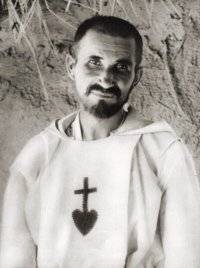The desert
The desert is a play by Tankred Dorst , which premiered on February 26, 2005 under the direction of Hermann Schmidt-Rahmer in the Dortmund Theater.
In eleven scenes, the viewer gets an insight into the life of the French officer, North Africa researcher and later hermit Baron Charles de Foucauld (* 1858, † 1916). In 1962, while working on a film about Camus , Tankred Dorst had observed the hermit's hermitage.
content
- Scene 2: Hotel Molière in Algiers
The wealthy, decadent colonial officer Lieutenant de Foucauld wants the Parisian prostitute Mimi to appear as Joan of Arc at a festival of the garrison in Algiers . Foucauld's friend Laperinne advises against it. That could not be expected of the officer's wives. The colonel thinks a lot of his lieutenant and wants to change his mind as well. Mimi is there. After the Parisian called the colonel an "ass", de Foucauld was immediately released from the French army.
- Scene 3: Who am I?
Laperinne strolls through Algiers with befriended young officers. He imagines his friend in distant France, but meets him on the way. A bad joke - the rich Foucauld, disguised as a ragged, lousy beggar, almost made himself unrecognizable.
- Scene 4: Farce
A leap forward in time: As a highly decorated and deserving North Africa researcher back home in France, Foucauld visits his lover Marie de Bondy in her castle. Marie wants to get rid of her hated husband Hector with a glass of prepared bitter almond liqueur. Her cousin Foucauld quickly drinks the glass and lies down to die in vain. The liquor was not poisoned. The amateur psychologist Marie only played with her lover for study purposes.
- Scene 6: Mon Ange
Marie mourns her husband in the accident at her castle. Hector shredded a terrorist bomb. Marie is free. Foucauld appears with his companion, the young Tuareg Ouksem. Marie gets a basket from the cousin.
- Scene 8: The words
Change of location: Foucauld, who became a hermit in the Hoggar Mountains , welcomes the pale bishop of Algiers in his lonely, narrow hermitage . The plump man has covered 2,327 kilometers across Algeria accompanied by the colonel (see above, scene 2), a telegraph engineer and Laperinnes. The bishop pays tribute to the hermit's civilizing achievement. Foucauld prophesies the outbreak of war in Europe: “People talk so much about him, and suddenly war arises from words.” Before talking to Foucauld, the bishop asked the novice Michel, who shares the dwelling with the hermit, about the righteousness of the cellmate questioned. The awesome Michel had painted a picture of a saint Foucauld and named Ouksem as his friend.
- Scene 9: I've been told
Ouksem sits next to the dead Foucauld. Chameleon and weaver bird chatter or chirp stupid stuff.
- Scene 10: Monologue and Scene 11: Antique, heroically strict
Laperinne, in search of his friend's murderer, flies with the corpse from oasis to oasis across the Sahara. Suspects have to put their fingers on the dead man's wound on the way. When the wound starts to bleed, the killer has been found. Laperinne finally succeeds. It is Ouksem.
shape
In the last scene, Ouksem turns out to be Foucauld's murderer (see above). Tankred Dorst prepares the audience in the first and sixth scenes for the disdainful deed: In the first scene Foucauld lets his companion Ouksem play with the precious dueling pistol that Marie gives the young Tuareg in the sixth scene.
How fascinating, but also devouring the Sahara is, paint "today's people" in the fifth scene in terrible pictures. By today's people, Tankred Dorst means our contemporaries, who tell stories several decades after the end of the story (that's the year 1916). People today also express themselves towards the end of the seventh scene. The latter turned out to be fantastic: the dead, disfigured by the bomb, plays a leading role alongside the repentant sinner Foucauld in front of the village priest.
Brief descriptions of the contents of the scenes, all of which are at the beginning of the text and scene contents differ in more than one case. For example, in the synopsis of scene 9, the desert is announced as the speaker. When things get serious, the Sahara is silent.
reception
- Announcement of the premiere on February 25, 2005 by Stefan Keim in the world : "The desert": Dortmund is performing a new Tankred Dorst
- February 27, 2005, Dortmund / dpa in schwaebische.de : Masterpiece: Tankred Dorst's "Desert" premiered
literature
Text output
- The desert. Pp. 109–162 in Tankred Dorst. Prospero's island and other pieces. Collaboration with Ursula Ehler . Work edition 8 (content: Othoon . Purcell's dream of King Arthur . The desert. I'm only here temporarily . Artist . Prospero's island . To practice the earthly. Frankfurt poetics lectures). Suhrkamp Verlag, Frankfurt am Main 2008 (1st edition), ISBN 978-3-518-42039-3 , 416 pages (edition used).
Remarks
- ↑ This primarily refers to the Algerian Sahara .
- ↑ The hermit has lived in his hermitage since 1911.
- ↑ Laperinne flies to the following oases in sequence: El Oued , In Salah , Bilma , El Golea , Beni Isguen , Ghardia , Guargla , Béni Abbès , Djanet , Ghadames , Timoudi , Teghit , Timia , Therir (French l'oasis d ' therir ) and Ghat (edition used, p. 160, 12th Zvu).
Individual evidence
- ^ Synopsis at suhrkamp.de . With a photo of the author by Isolde Ohlbaum
- ↑ To practice in the earthly. Frankfurt Poetics Lectures in the edition used, pp. 361,11. Zvo
- ↑ Edition used, p. 123, 3rd Zvu
- ↑ Edition used, p. 143, 6th Zvu
- ↑ Edition used, p. 155, 14. Zvo
